Strathclyde MBA Project: New Cab Business Model Development in Delhi
VerifiedAdded on 2022/10/17
|106
|27349
|186
Project
AI Summary
This MBA project explores the development of a new cab business model for Delhi, India. The research investigates the current cab market, dominated by aggregators like Uber and Ola, and identifies gaps in customer service and unmet needs. The project employs both primary data collection through questionnaires and interviews and secondary data from academic journals and news articles. The RIDE business model is proposed to provide in-depth understanding of on-demand business model and generate stronger value propositions for the customers. The findings highlight the importance of factors like price, transparency, safety, and ease of use, as well as the significance of customer service and offers in attracting and retaining customers. The study also discusses the use of the SERVQUAL model in analyzing the data. Recommendations are provided to improve cab services and address customer satisfaction, offering valuable insights for future research and the development of a successful cab business in Delhi.
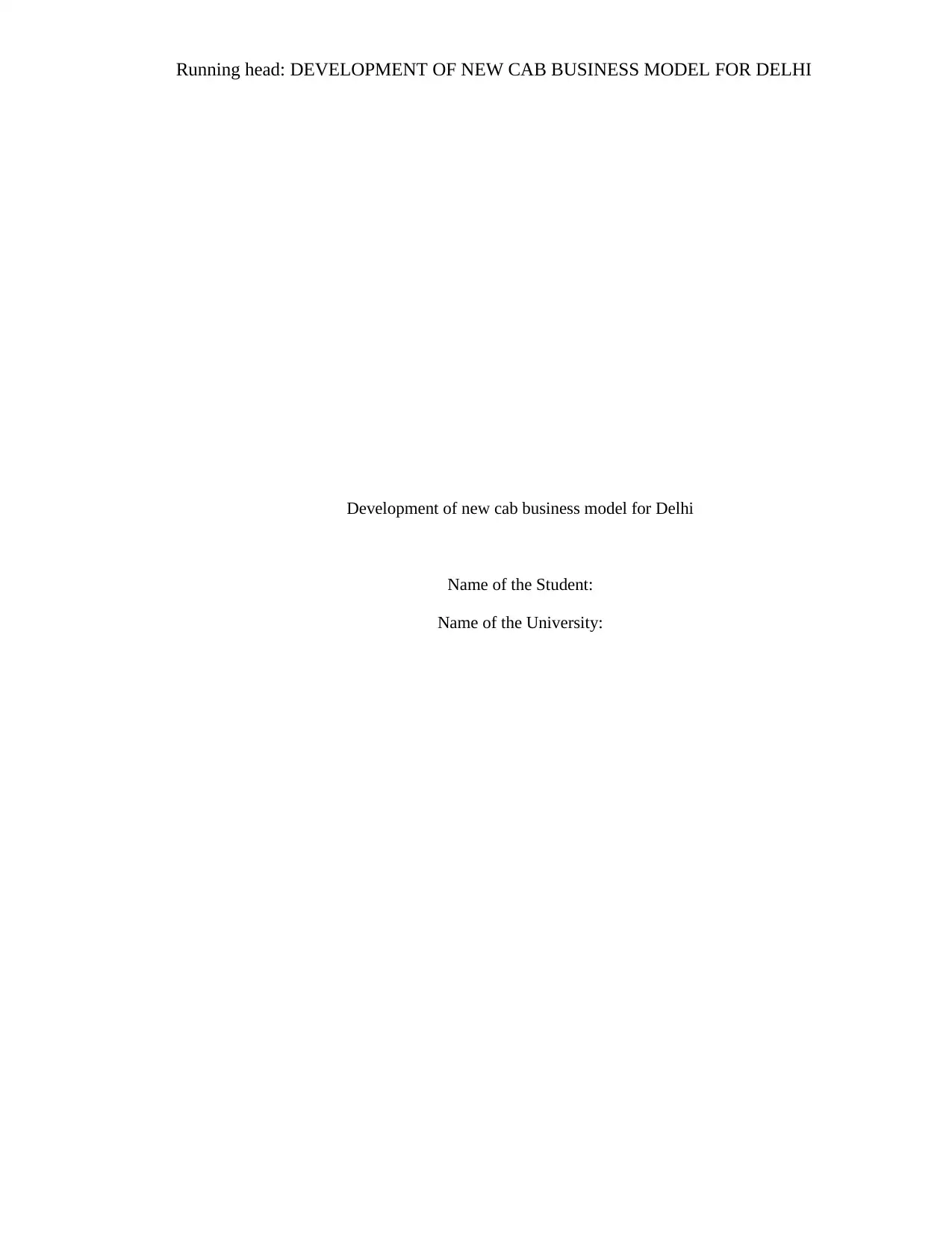
Running head: DEVELOPMENT OF NEW CAB BUSINESS MODEL FOR DELHI
Development of new cab business model for Delhi
Name of the Student:
Name of the University:
Development of new cab business model for Delhi
Name of the Student:
Name of the University:
Paraphrase This Document
Need a fresh take? Get an instant paraphrase of this document with our AI Paraphraser

DEVELOPMENT OF NEW CAB BUSINESS MODEL FOR DELHI
Abstract
The paper is concentrated on development of new cab business model for Delhi. This research work
is mainly supported on disruptive innovation in Indian cab market where the industry is witnessed
cab aggregation by means of mobile application, leads to result of technological progress to make
use of transportation easier. The findings of this paper are that most of population of Delhi used
Uber cab services as compared to Meru and Ola. While booking the cab, online payment method is
most popular. Price, transparency, safety, security and ease of use are the factors affect the
transportation services. Most of the cab services are provided with moderately affordable prices of
the cab so that middle level people can ride on it. In this paper RIDE business model is used to
provide with in-depth understanding of on-demand business model such that it is provide with new
business idea to generate stronger value propositions for the customers. RIDE model is also
proposed for benefiting the future researchers so that they are encouraged towards further research
in the future. The paper discusses on the importance of the customer service while booking the cab
along with service offers the customers. If the customers are provided services on their demand and
needs, then they are loyal to the cab company and used their services continuously when travelling.
The data sources used to analyze the topic are primary and secondary. Primary is conducted through
questionnaires and interview and secondary through academic journals, websites and news articles.
The recorded responses will help to analyze the approach of customers while booking the cab. In
the discussion section, SERVQUAL model is linked with the analyzed data and literature study
findings. This study is also providing with recommendations to make improvement over cab
services which will benefit the customers to use cab services.
Keywords: Cab aggregator, disruptive innovation, transportation, mobile application.
Page 1
Abstract
The paper is concentrated on development of new cab business model for Delhi. This research work
is mainly supported on disruptive innovation in Indian cab market where the industry is witnessed
cab aggregation by means of mobile application, leads to result of technological progress to make
use of transportation easier. The findings of this paper are that most of population of Delhi used
Uber cab services as compared to Meru and Ola. While booking the cab, online payment method is
most popular. Price, transparency, safety, security and ease of use are the factors affect the
transportation services. Most of the cab services are provided with moderately affordable prices of
the cab so that middle level people can ride on it. In this paper RIDE business model is used to
provide with in-depth understanding of on-demand business model such that it is provide with new
business idea to generate stronger value propositions for the customers. RIDE model is also
proposed for benefiting the future researchers so that they are encouraged towards further research
in the future. The paper discusses on the importance of the customer service while booking the cab
along with service offers the customers. If the customers are provided services on their demand and
needs, then they are loyal to the cab company and used their services continuously when travelling.
The data sources used to analyze the topic are primary and secondary. Primary is conducted through
questionnaires and interview and secondary through academic journals, websites and news articles.
The recorded responses will help to analyze the approach of customers while booking the cab. In
the discussion section, SERVQUAL model is linked with the analyzed data and literature study
findings. This study is also providing with recommendations to make improvement over cab
services which will benefit the customers to use cab services.
Keywords: Cab aggregator, disruptive innovation, transportation, mobile application.
Page 1
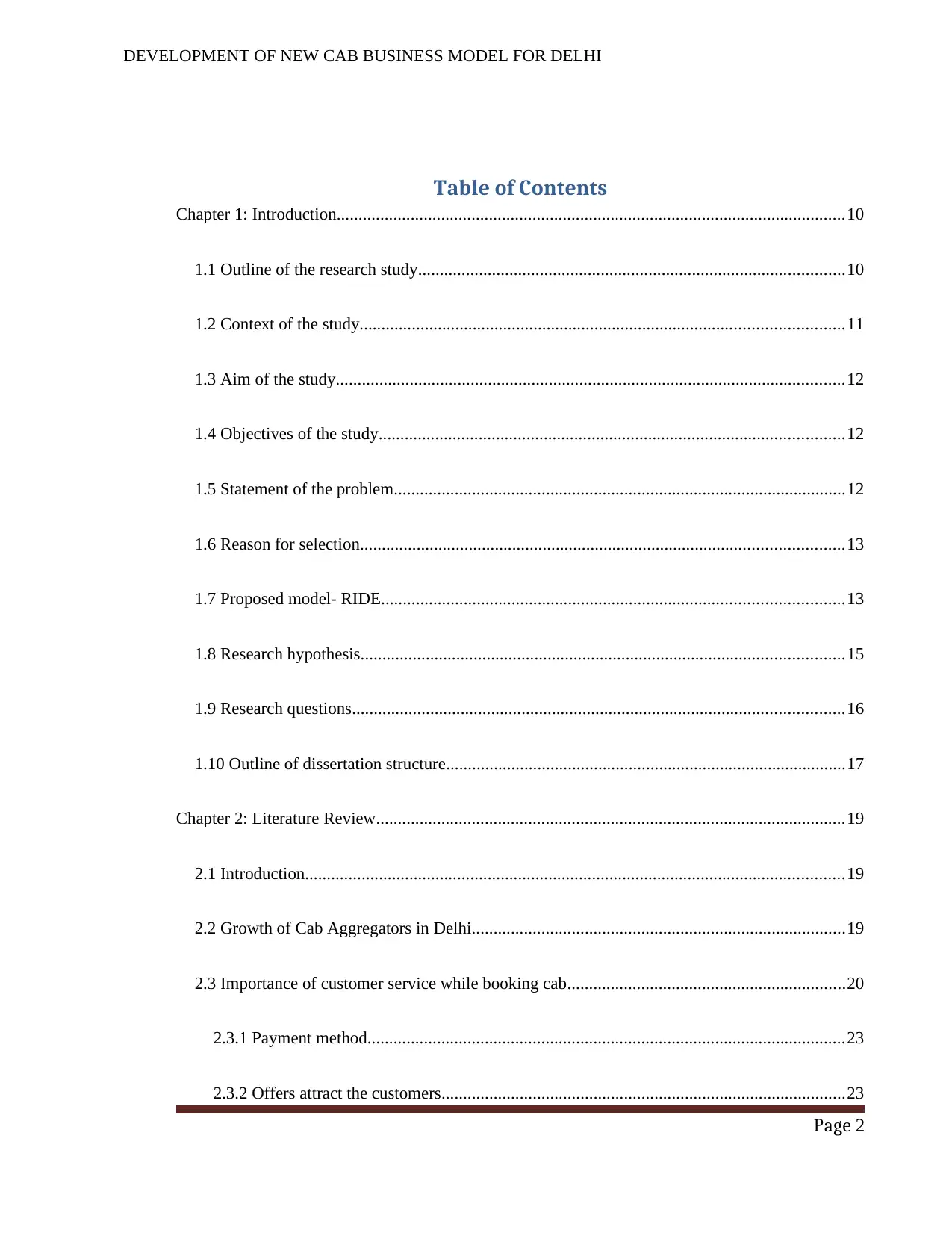
DEVELOPMENT OF NEW CAB BUSINESS MODEL FOR DELHI
Table of Contents
Chapter 1: Introduction.....................................................................................................................10
1.1 Outline of the research study..................................................................................................10
1.2 Context of the study...............................................................................................................11
1.3 Aim of the study.....................................................................................................................12
1.4 Objectives of the study...........................................................................................................12
1.5 Statement of the problem........................................................................................................12
1.6 Reason for selection...............................................................................................................13
1.7 Proposed model- RIDE..........................................................................................................13
1.8 Research hypothesis...............................................................................................................15
1.9 Research questions.................................................................................................................16
1.10 Outline of dissertation structure............................................................................................17
Chapter 2: Literature Review............................................................................................................19
2.1 Introduction............................................................................................................................19
2.2 Growth of Cab Aggregators in Delhi......................................................................................19
2.3 Importance of customer service while booking cab................................................................20
2.3.1 Payment method..............................................................................................................23
2.3.2 Offers attract the customers.............................................................................................23
Page 2
Table of Contents
Chapter 1: Introduction.....................................................................................................................10
1.1 Outline of the research study..................................................................................................10
1.2 Context of the study...............................................................................................................11
1.3 Aim of the study.....................................................................................................................12
1.4 Objectives of the study...........................................................................................................12
1.5 Statement of the problem........................................................................................................12
1.6 Reason for selection...............................................................................................................13
1.7 Proposed model- RIDE..........................................................................................................13
1.8 Research hypothesis...............................................................................................................15
1.9 Research questions.................................................................................................................16
1.10 Outline of dissertation structure............................................................................................17
Chapter 2: Literature Review............................................................................................................19
2.1 Introduction............................................................................................................................19
2.2 Growth of Cab Aggregators in Delhi......................................................................................19
2.3 Importance of customer service while booking cab................................................................20
2.3.1 Payment method..............................................................................................................23
2.3.2 Offers attract the customers.............................................................................................23
Page 2
⊘ This is a preview!⊘
Do you want full access?
Subscribe today to unlock all pages.

Trusted by 1+ million students worldwide
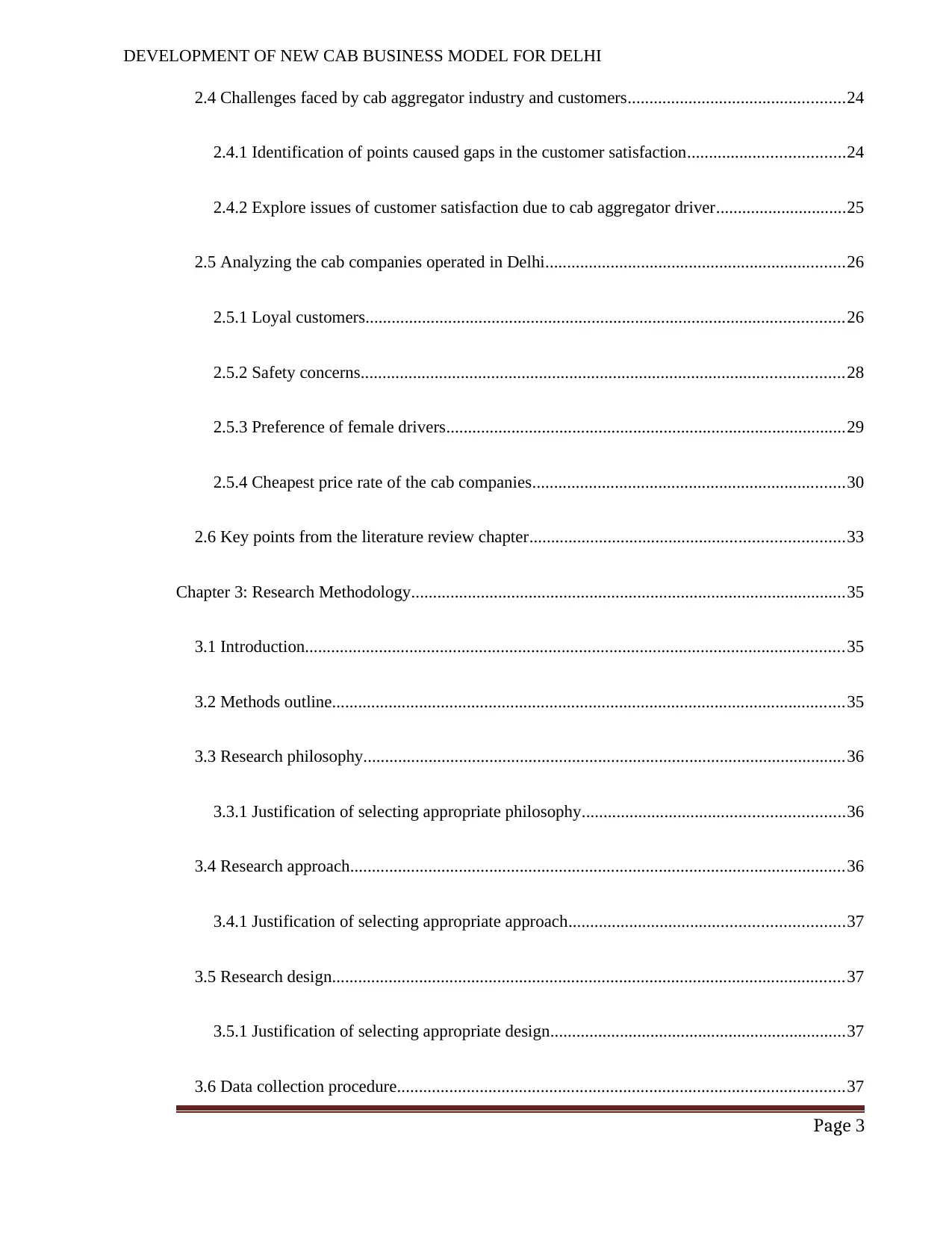
DEVELOPMENT OF NEW CAB BUSINESS MODEL FOR DELHI
2.4 Challenges faced by cab aggregator industry and customers..................................................24
2.4.1 Identification of points caused gaps in the customer satisfaction....................................24
2.4.2 Explore issues of customer satisfaction due to cab aggregator driver..............................25
2.5 Analyzing the cab companies operated in Delhi.....................................................................26
2.5.1 Loyal customers..............................................................................................................26
2.5.2 Safety concerns...............................................................................................................28
2.5.3 Preference of female drivers............................................................................................29
2.5.4 Cheapest price rate of the cab companies........................................................................30
2.6 Key points from the literature review chapter........................................................................33
Chapter 3: Research Methodology....................................................................................................35
3.1 Introduction............................................................................................................................35
3.2 Methods outline......................................................................................................................35
3.3 Research philosophy...............................................................................................................36
3.3.1 Justification of selecting appropriate philosophy............................................................36
3.4 Research approach..................................................................................................................36
3.4.1 Justification of selecting appropriate approach...............................................................37
3.5 Research design......................................................................................................................37
3.5.1 Justification of selecting appropriate design....................................................................37
3.6 Data collection procedure.......................................................................................................37
Page 3
2.4 Challenges faced by cab aggregator industry and customers..................................................24
2.4.1 Identification of points caused gaps in the customer satisfaction....................................24
2.4.2 Explore issues of customer satisfaction due to cab aggregator driver..............................25
2.5 Analyzing the cab companies operated in Delhi.....................................................................26
2.5.1 Loyal customers..............................................................................................................26
2.5.2 Safety concerns...............................................................................................................28
2.5.3 Preference of female drivers............................................................................................29
2.5.4 Cheapest price rate of the cab companies........................................................................30
2.6 Key points from the literature review chapter........................................................................33
Chapter 3: Research Methodology....................................................................................................35
3.1 Introduction............................................................................................................................35
3.2 Methods outline......................................................................................................................35
3.3 Research philosophy...............................................................................................................36
3.3.1 Justification of selecting appropriate philosophy............................................................36
3.4 Research approach..................................................................................................................36
3.4.1 Justification of selecting appropriate approach...............................................................37
3.5 Research design......................................................................................................................37
3.5.1 Justification of selecting appropriate design....................................................................37
3.6 Data collection procedure.......................................................................................................37
Page 3
Paraphrase This Document
Need a fresh take? Get an instant paraphrase of this document with our AI Paraphraser

DEVELOPMENT OF NEW CAB BUSINESS MODEL FOR DELHI
3.6.1 Data sources used............................................................................................................38
3.6.2 Data analysis techniques.................................................................................................39
3.7 Population and sample............................................................................................................39
3.8 Ethical considerations.............................................................................................................39
3.9 Summary................................................................................................................................40
Chapter 4: Data analysis and findings...............................................................................................41
4.1 Introduction............................................................................................................................41
4.2 Quantitative Data Analysis.....................................................................................................41
4.2.1 Summary on quantitative findings...................................................................................63
4.3 Qualitative Data Analysis.......................................................................................................63
4.3.1 Learning from qualitative findings..................................................................................65
4.4 Summary................................................................................................................................65
Chapter 5: Discussion.......................................................................................................................67
5.1 Discussion on the cab business model....................................................................................67
5.2 Discussion on the success story of cab services in Delhi........................................................68
5.3 Discussion on importance of consumer behaviour and perception towards the cab aggregators
.....................................................................................................................................................71
5.4 Discussion on data analysis results and findings....................................................................73
5.5 Factors affecting the customer satisfaction in cab service market in India.............................77
Page 4
3.6.1 Data sources used............................................................................................................38
3.6.2 Data analysis techniques.................................................................................................39
3.7 Population and sample............................................................................................................39
3.8 Ethical considerations.............................................................................................................39
3.9 Summary................................................................................................................................40
Chapter 4: Data analysis and findings...............................................................................................41
4.1 Introduction............................................................................................................................41
4.2 Quantitative Data Analysis.....................................................................................................41
4.2.1 Summary on quantitative findings...................................................................................63
4.3 Qualitative Data Analysis.......................................................................................................63
4.3.1 Learning from qualitative findings..................................................................................65
4.4 Summary................................................................................................................................65
Chapter 5: Discussion.......................................................................................................................67
5.1 Discussion on the cab business model....................................................................................67
5.2 Discussion on the success story of cab services in Delhi........................................................68
5.3 Discussion on importance of consumer behaviour and perception towards the cab aggregators
.....................................................................................................................................................71
5.4 Discussion on data analysis results and findings....................................................................73
5.5 Factors affecting the customer satisfaction in cab service market in India.............................77
Page 4
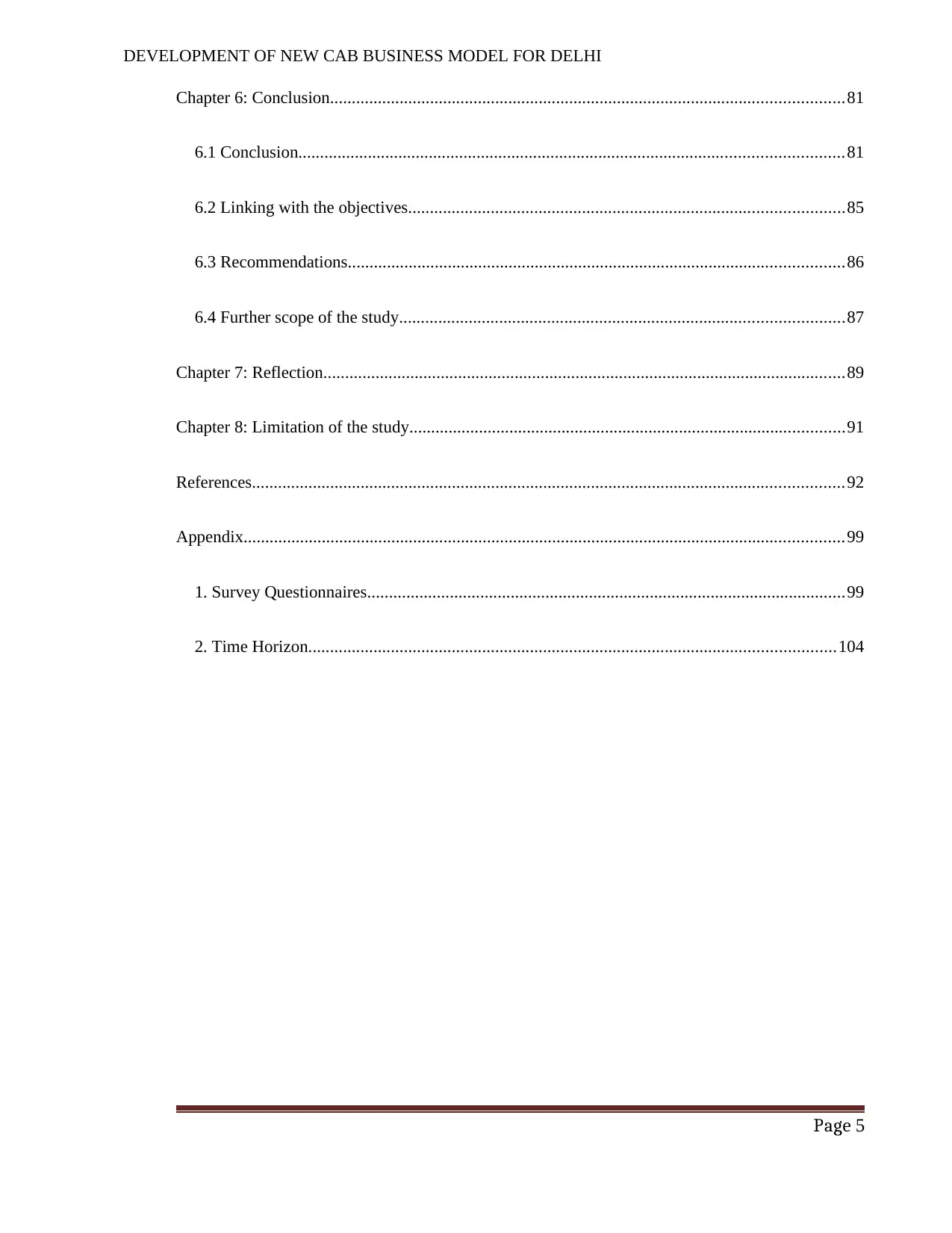
DEVELOPMENT OF NEW CAB BUSINESS MODEL FOR DELHI
Chapter 6: Conclusion......................................................................................................................81
6.1 Conclusion.............................................................................................................................81
6.2 Linking with the objectives....................................................................................................85
6.3 Recommendations..................................................................................................................86
6.4 Further scope of the study......................................................................................................87
Chapter 7: Reflection........................................................................................................................89
Chapter 8: Limitation of the study....................................................................................................91
References........................................................................................................................................92
Appendix..........................................................................................................................................99
1. Survey Questionnaires..............................................................................................................99
2. Time Horizon.........................................................................................................................104
Page 5
Chapter 6: Conclusion......................................................................................................................81
6.1 Conclusion.............................................................................................................................81
6.2 Linking with the objectives....................................................................................................85
6.3 Recommendations..................................................................................................................86
6.4 Further scope of the study......................................................................................................87
Chapter 7: Reflection........................................................................................................................89
Chapter 8: Limitation of the study....................................................................................................91
References........................................................................................................................................92
Appendix..........................................................................................................................................99
1. Survey Questionnaires..............................................................................................................99
2. Time Horizon.........................................................................................................................104
Page 5
⊘ This is a preview!⊘
Do you want full access?
Subscribe today to unlock all pages.

Trusted by 1+ million students worldwide

DEVELOPMENT OF NEW CAB BUSINESS MODEL FOR DELHI
Table of Figures
Figure 1.1: Proposed RIDE model....................................................................................................14
Figure 4.1: Gender............................................................................................................................42
Figure 4.2: Age.................................................................................................................................43
Figure 4.3: Time to travel by cab......................................................................................................44
Figure 4.4: Use cab for personal or professional travel.....................................................................45
Figure 4.5: Online cab aggregator typically use................................................................................46
Figure 4.6: Better payment method for the online cab transportation...............................................47
Figure 4.7: Factor important for selecting a transportation form.......................................................48
Figure 4.8: Prefer to compare the cab operators availability plus transparency on fares from unified
platform............................................................................................................................................49
Figure 4.9: Prices of cab affordable..................................................................................................51
Figure 4.10: Offers require providing in the cab services.................................................................52
Figure 4.11: Preferable to get female drivers at any time of the day for the female passengers........53
Figure 4.12: Situation prefer to get carpool......................................................................................54
Figure 4.13: Primary reason to opt car pool......................................................................................55
Figure 4.14: Information require about the car owner related to security perspective.......................56
Figure 4.15: Suitable pricing system for the shared journey.............................................................57
Figure 4.16: Recommend cab services to friend or colleague...........................................................58
Page 6
Table of Figures
Figure 1.1: Proposed RIDE model....................................................................................................14
Figure 4.1: Gender............................................................................................................................42
Figure 4.2: Age.................................................................................................................................43
Figure 4.3: Time to travel by cab......................................................................................................44
Figure 4.4: Use cab for personal or professional travel.....................................................................45
Figure 4.5: Online cab aggregator typically use................................................................................46
Figure 4.6: Better payment method for the online cab transportation...............................................47
Figure 4.7: Factor important for selecting a transportation form.......................................................48
Figure 4.8: Prefer to compare the cab operators availability plus transparency on fares from unified
platform............................................................................................................................................49
Figure 4.9: Prices of cab affordable..................................................................................................51
Figure 4.10: Offers require providing in the cab services.................................................................52
Figure 4.11: Preferable to get female drivers at any time of the day for the female passengers........53
Figure 4.12: Situation prefer to get carpool......................................................................................54
Figure 4.13: Primary reason to opt car pool......................................................................................55
Figure 4.14: Information require about the car owner related to security perspective.......................56
Figure 4.15: Suitable pricing system for the shared journey.............................................................57
Figure 4.16: Recommend cab services to friend or colleague...........................................................58
Page 6
Paraphrase This Document
Need a fresh take? Get an instant paraphrase of this document with our AI Paraphraser
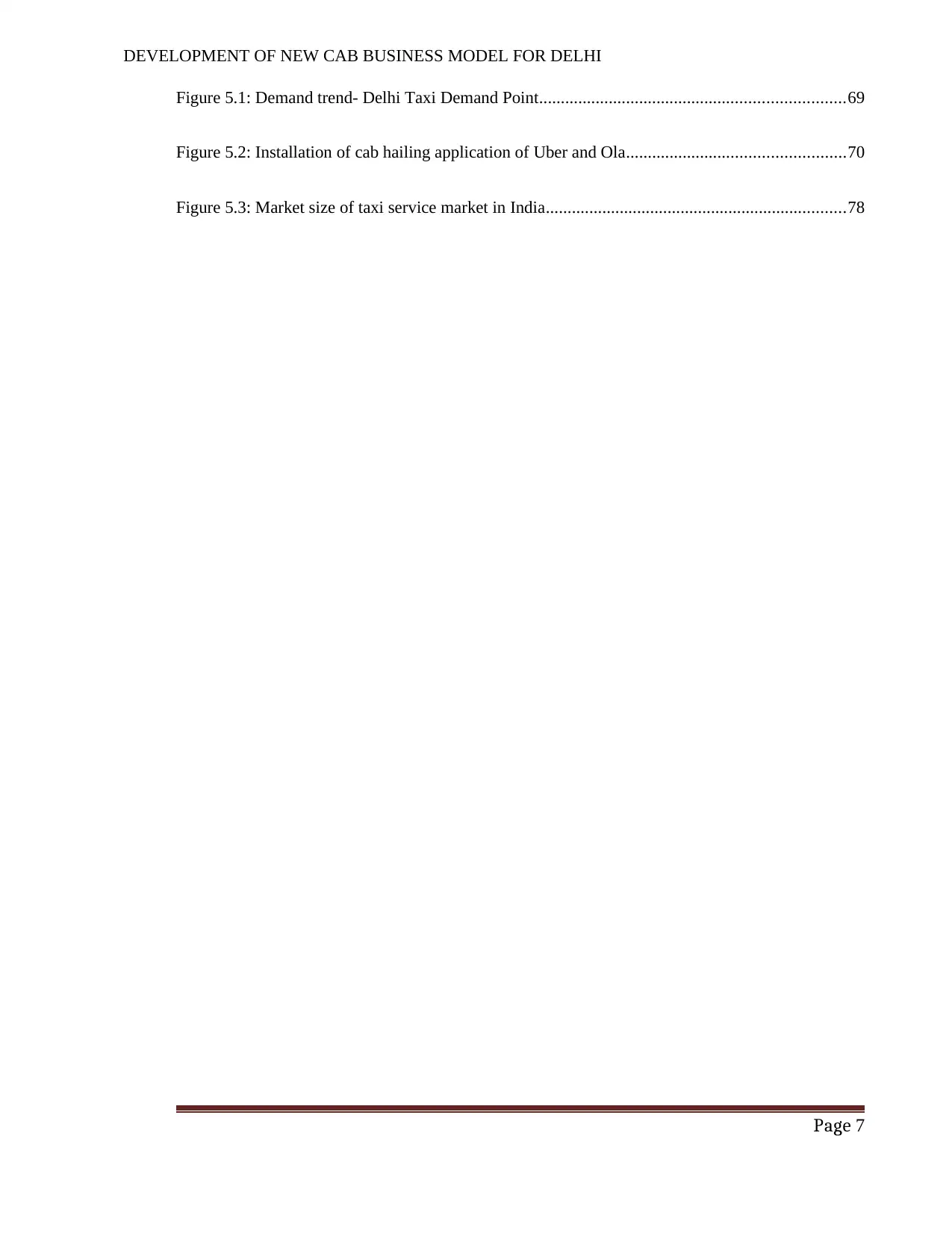
DEVELOPMENT OF NEW CAB BUSINESS MODEL FOR DELHI
Figure 5.1: Demand trend- Delhi Taxi Demand Point......................................................................69
Figure 5.2: Installation of cab hailing application of Uber and Ola..................................................70
Figure 5.3: Market size of taxi service market in India.....................................................................78
Page 7
Figure 5.1: Demand trend- Delhi Taxi Demand Point......................................................................69
Figure 5.2: Installation of cab hailing application of Uber and Ola..................................................70
Figure 5.3: Market size of taxi service market in India.....................................................................78
Page 7
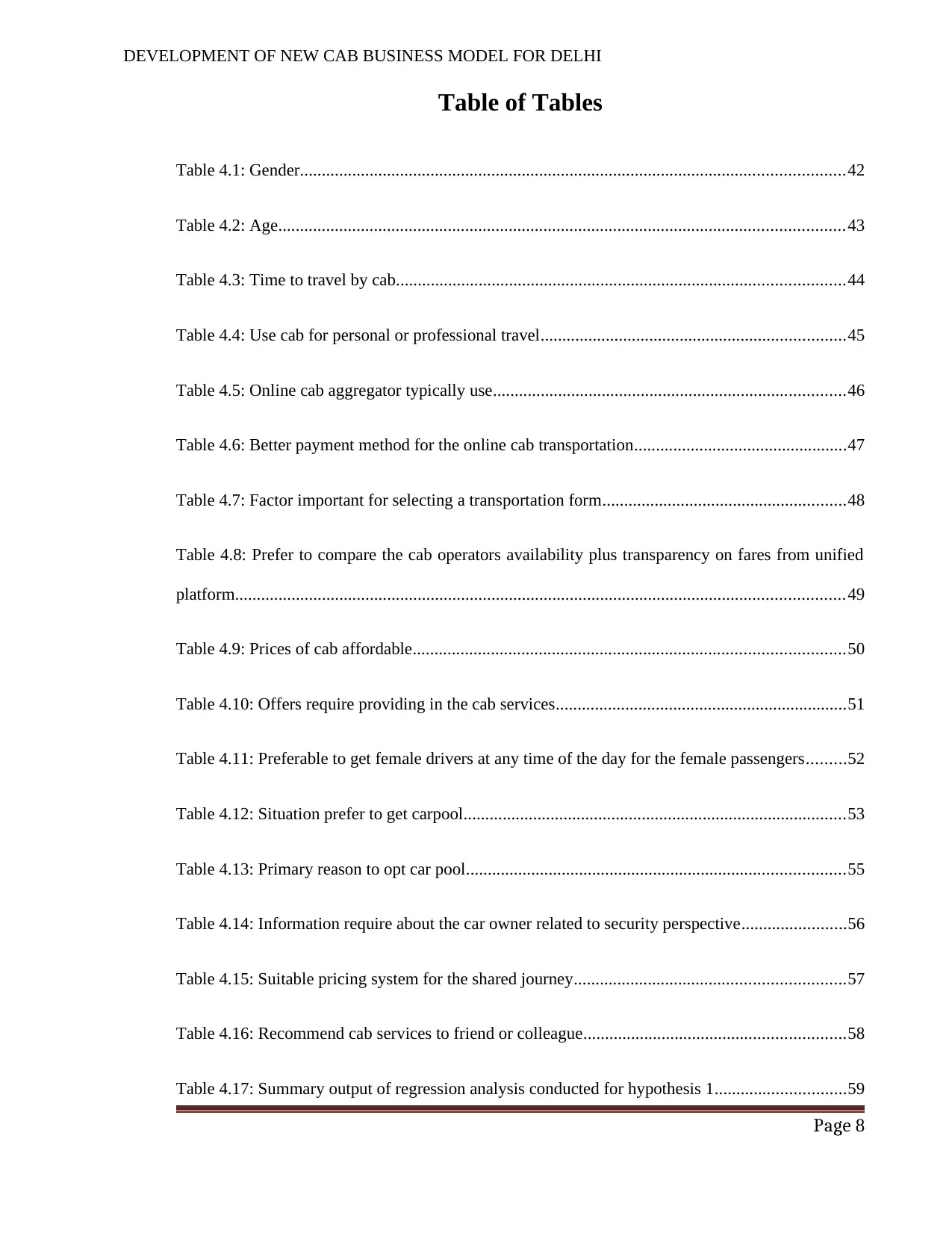
DEVELOPMENT OF NEW CAB BUSINESS MODEL FOR DELHI
Table of Tables
Table 4.1: Gender.............................................................................................................................42
Table 4.2: Age..................................................................................................................................43
Table 4.3: Time to travel by cab.......................................................................................................44
Table 4.4: Use cab for personal or professional travel......................................................................45
Table 4.5: Online cab aggregator typically use.................................................................................46
Table 4.6: Better payment method for the online cab transportation.................................................47
Table 4.7: Factor important for selecting a transportation form........................................................48
Table 4.8: Prefer to compare the cab operators availability plus transparency on fares from unified
platform............................................................................................................................................49
Table 4.9: Prices of cab affordable...................................................................................................50
Table 4.10: Offers require providing in the cab services...................................................................51
Table 4.11: Preferable to get female drivers at any time of the day for the female passengers.........52
Table 4.12: Situation prefer to get carpool........................................................................................53
Table 4.13: Primary reason to opt car pool.......................................................................................55
Table 4.14: Information require about the car owner related to security perspective........................56
Table 4.15: Suitable pricing system for the shared journey..............................................................57
Table 4.16: Recommend cab services to friend or colleague............................................................58
Table 4.17: Summary output of regression analysis conducted for hypothesis 1..............................59
Page 8
Table of Tables
Table 4.1: Gender.............................................................................................................................42
Table 4.2: Age..................................................................................................................................43
Table 4.3: Time to travel by cab.......................................................................................................44
Table 4.4: Use cab for personal or professional travel......................................................................45
Table 4.5: Online cab aggregator typically use.................................................................................46
Table 4.6: Better payment method for the online cab transportation.................................................47
Table 4.7: Factor important for selecting a transportation form........................................................48
Table 4.8: Prefer to compare the cab operators availability plus transparency on fares from unified
platform............................................................................................................................................49
Table 4.9: Prices of cab affordable...................................................................................................50
Table 4.10: Offers require providing in the cab services...................................................................51
Table 4.11: Preferable to get female drivers at any time of the day for the female passengers.........52
Table 4.12: Situation prefer to get carpool........................................................................................53
Table 4.13: Primary reason to opt car pool.......................................................................................55
Table 4.14: Information require about the car owner related to security perspective........................56
Table 4.15: Suitable pricing system for the shared journey..............................................................57
Table 4.16: Recommend cab services to friend or colleague............................................................58
Table 4.17: Summary output of regression analysis conducted for hypothesis 1..............................59
Page 8
⊘ This is a preview!⊘
Do you want full access?
Subscribe today to unlock all pages.

Trusted by 1+ million students worldwide
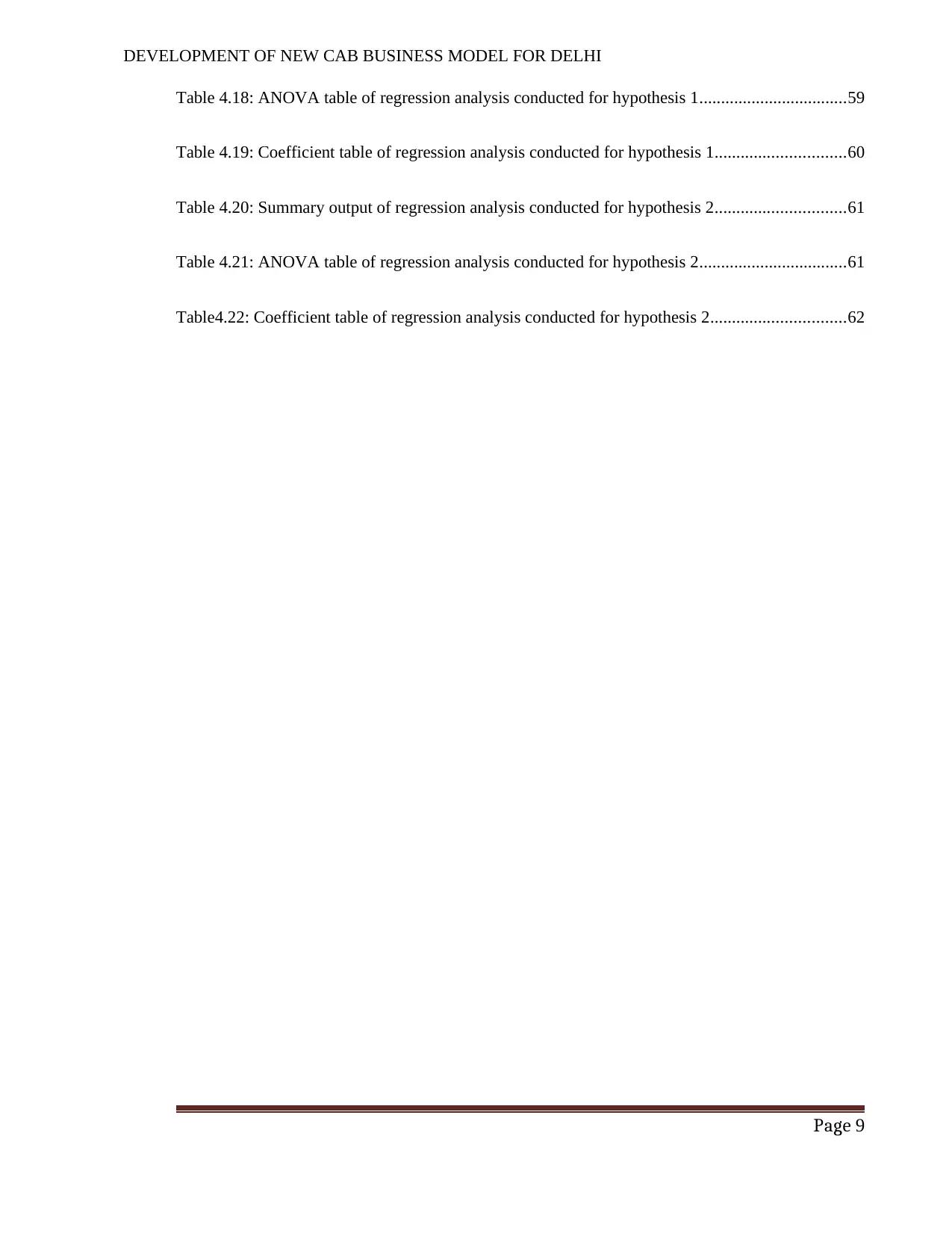
DEVELOPMENT OF NEW CAB BUSINESS MODEL FOR DELHI
Table 4.18: ANOVA table of regression analysis conducted for hypothesis 1..................................59
Table 4.19: Coefficient table of regression analysis conducted for hypothesis 1..............................60
Table 4.20: Summary output of regression analysis conducted for hypothesis 2..............................61
Table 4.21: ANOVA table of regression analysis conducted for hypothesis 2..................................61
Table4.22: Coefficient table of regression analysis conducted for hypothesis 2...............................62
Page 9
Table 4.18: ANOVA table of regression analysis conducted for hypothesis 1..................................59
Table 4.19: Coefficient table of regression analysis conducted for hypothesis 1..............................60
Table 4.20: Summary output of regression analysis conducted for hypothesis 2..............................61
Table 4.21: ANOVA table of regression analysis conducted for hypothesis 2..................................61
Table4.22: Coefficient table of regression analysis conducted for hypothesis 2...............................62
Page 9
Paraphrase This Document
Need a fresh take? Get an instant paraphrase of this document with our AI Paraphraser
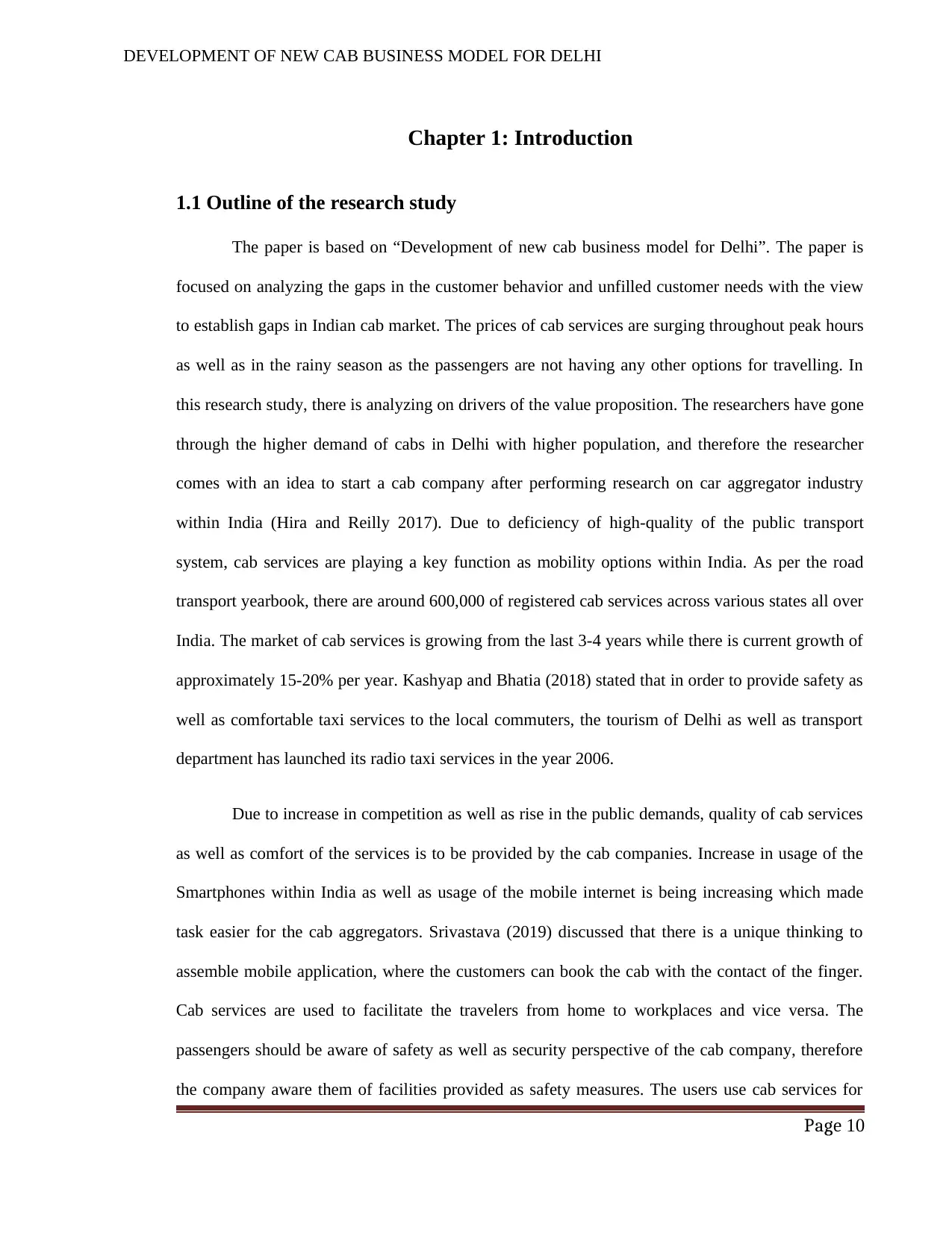
DEVELOPMENT OF NEW CAB BUSINESS MODEL FOR DELHI
Chapter 1: Introduction
1.1 Outline of the research study
The paper is based on “Development of new cab business model for Delhi”. The paper is
focused on analyzing the gaps in the customer behavior and unfilled customer needs with the view
to establish gaps in Indian cab market. The prices of cab services are surging throughout peak hours
as well as in the rainy season as the passengers are not having any other options for travelling. In
this research study, there is analyzing on drivers of the value proposition. The researchers have gone
through the higher demand of cabs in Delhi with higher population, and therefore the researcher
comes with an idea to start a cab company after performing research on car aggregator industry
within India (Hira and Reilly 2017). Due to deficiency of high-quality of the public transport
system, cab services are playing a key function as mobility options within India. As per the road
transport yearbook, there are around 600,000 of registered cab services across various states all over
India. The market of cab services is growing from the last 3-4 years while there is current growth of
approximately 15-20% per year. Kashyap and Bhatia (2018) stated that in order to provide safety as
well as comfortable taxi services to the local commuters, the tourism of Delhi as well as transport
department has launched its radio taxi services in the year 2006.
Due to increase in competition as well as rise in the public demands, quality of cab services
as well as comfort of the services is to be provided by the cab companies. Increase in usage of the
Smartphones within India as well as usage of the mobile internet is being increasing which made
task easier for the cab aggregators. Srivastava (2019) discussed that there is a unique thinking to
assemble mobile application, where the customers can book the cab with the contact of the finger.
Cab services are used to facilitate the travelers from home to workplaces and vice versa. The
passengers should be aware of safety as well as security perspective of the cab company, therefore
the company aware them of facilities provided as safety measures. The users use cab services for
Page 10
Chapter 1: Introduction
1.1 Outline of the research study
The paper is based on “Development of new cab business model for Delhi”. The paper is
focused on analyzing the gaps in the customer behavior and unfilled customer needs with the view
to establish gaps in Indian cab market. The prices of cab services are surging throughout peak hours
as well as in the rainy season as the passengers are not having any other options for travelling. In
this research study, there is analyzing on drivers of the value proposition. The researchers have gone
through the higher demand of cabs in Delhi with higher population, and therefore the researcher
comes with an idea to start a cab company after performing research on car aggregator industry
within India (Hira and Reilly 2017). Due to deficiency of high-quality of the public transport
system, cab services are playing a key function as mobility options within India. As per the road
transport yearbook, there are around 600,000 of registered cab services across various states all over
India. The market of cab services is growing from the last 3-4 years while there is current growth of
approximately 15-20% per year. Kashyap and Bhatia (2018) stated that in order to provide safety as
well as comfortable taxi services to the local commuters, the tourism of Delhi as well as transport
department has launched its radio taxi services in the year 2006.
Due to increase in competition as well as rise in the public demands, quality of cab services
as well as comfort of the services is to be provided by the cab companies. Increase in usage of the
Smartphones within India as well as usage of the mobile internet is being increasing which made
task easier for the cab aggregators. Srivastava (2019) discussed that there is a unique thinking to
assemble mobile application, where the customers can book the cab with the contact of the finger.
Cab services are used to facilitate the travelers from home to workplaces and vice versa. The
passengers should be aware of safety as well as security perspective of the cab company, therefore
the company aware them of facilities provided as safety measures. The users use cab services for
Page 10
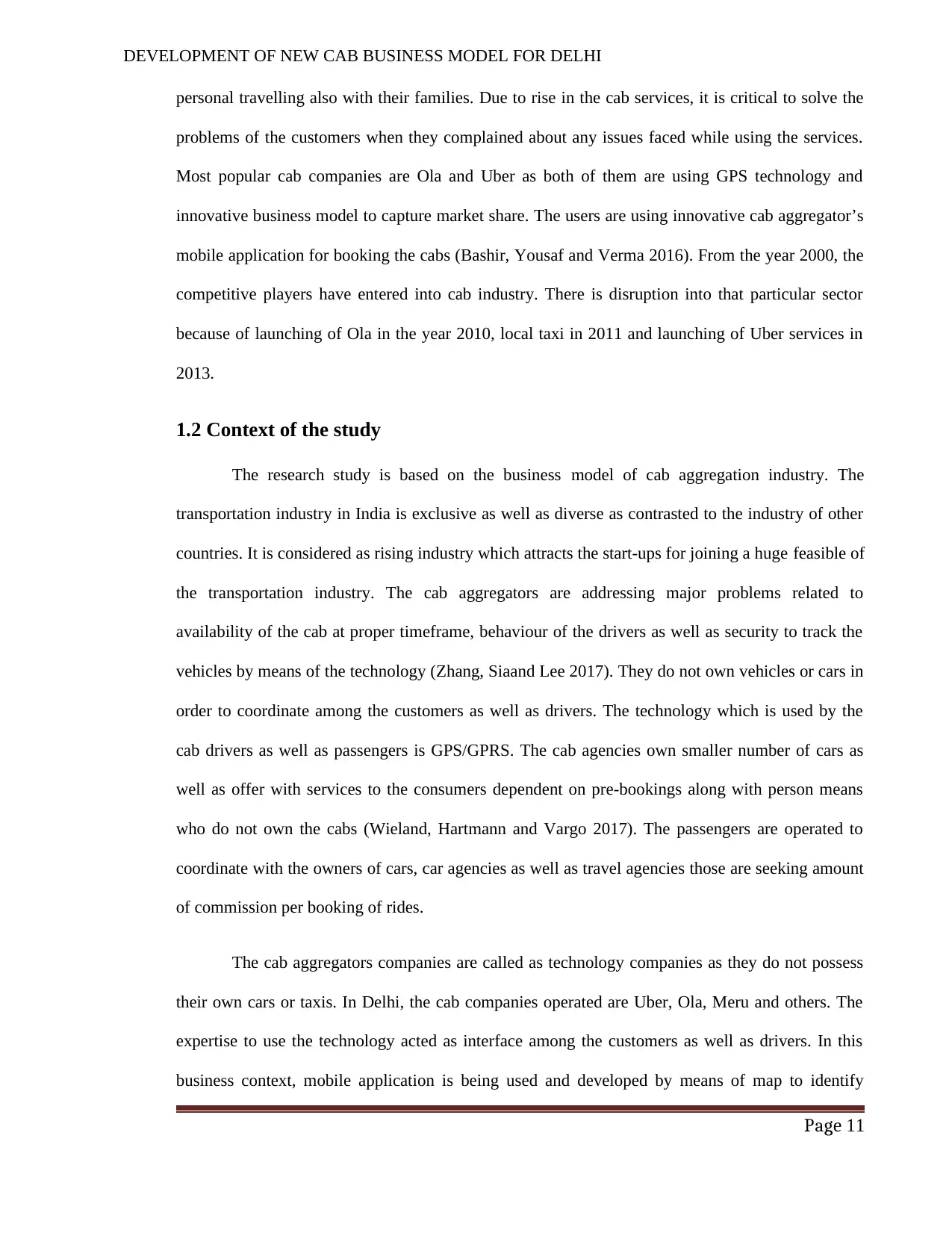
DEVELOPMENT OF NEW CAB BUSINESS MODEL FOR DELHI
personal travelling also with their families. Due to rise in the cab services, it is critical to solve the
problems of the customers when they complained about any issues faced while using the services.
Most popular cab companies are Ola and Uber as both of them are using GPS technology and
innovative business model to capture market share. The users are using innovative cab aggregator’s
mobile application for booking the cabs (Bashir, Yousaf and Verma 2016). From the year 2000, the
competitive players have entered into cab industry. There is disruption into that particular sector
because of launching of Ola in the year 2010, local taxi in 2011 and launching of Uber services in
2013.
1.2 Context of the study
The research study is based on the business model of cab aggregation industry. The
transportation industry in India is exclusive as well as diverse as contrasted to the industry of other
countries. It is considered as rising industry which attracts the start-ups for joining a huge feasible of
the transportation industry. The cab aggregators are addressing major problems related to
availability of the cab at proper timeframe, behaviour of the drivers as well as security to track the
vehicles by means of the technology (Zhang, Siaand Lee 2017). They do not own vehicles or cars in
order to coordinate among the customers as well as drivers. The technology which is used by the
cab drivers as well as passengers is GPS/GPRS. The cab agencies own smaller number of cars as
well as offer with services to the consumers dependent on pre-bookings along with person means
who do not own the cabs (Wieland, Hartmann and Vargo 2017). The passengers are operated to
coordinate with the owners of cars, car agencies as well as travel agencies those are seeking amount
of commission per booking of rides.
The cab aggregators companies are called as technology companies as they do not possess
their own cars or taxis. In Delhi, the cab companies operated are Uber, Ola, Meru and others. The
expertise to use the technology acted as interface among the customers as well as drivers. In this
business context, mobile application is being used and developed by means of map to identify
Page 11
personal travelling also with their families. Due to rise in the cab services, it is critical to solve the
problems of the customers when they complained about any issues faced while using the services.
Most popular cab companies are Ola and Uber as both of them are using GPS technology and
innovative business model to capture market share. The users are using innovative cab aggregator’s
mobile application for booking the cabs (Bashir, Yousaf and Verma 2016). From the year 2000, the
competitive players have entered into cab industry. There is disruption into that particular sector
because of launching of Ola in the year 2010, local taxi in 2011 and launching of Uber services in
2013.
1.2 Context of the study
The research study is based on the business model of cab aggregation industry. The
transportation industry in India is exclusive as well as diverse as contrasted to the industry of other
countries. It is considered as rising industry which attracts the start-ups for joining a huge feasible of
the transportation industry. The cab aggregators are addressing major problems related to
availability of the cab at proper timeframe, behaviour of the drivers as well as security to track the
vehicles by means of the technology (Zhang, Siaand Lee 2017). They do not own vehicles or cars in
order to coordinate among the customers as well as drivers. The technology which is used by the
cab drivers as well as passengers is GPS/GPRS. The cab agencies own smaller number of cars as
well as offer with services to the consumers dependent on pre-bookings along with person means
who do not own the cabs (Wieland, Hartmann and Vargo 2017). The passengers are operated to
coordinate with the owners of cars, car agencies as well as travel agencies those are seeking amount
of commission per booking of rides.
The cab aggregators companies are called as technology companies as they do not possess
their own cars or taxis. In Delhi, the cab companies operated are Uber, Ola, Meru and others. The
expertise to use the technology acted as interface among the customers as well as drivers. In this
business context, mobile application is being used and developed by means of map to identify
Page 11
⊘ This is a preview!⊘
Do you want full access?
Subscribe today to unlock all pages.

Trusted by 1+ million students worldwide
1 out of 106
Related Documents
Your All-in-One AI-Powered Toolkit for Academic Success.
+13062052269
info@desklib.com
Available 24*7 on WhatsApp / Email
![[object Object]](/_next/static/media/star-bottom.7253800d.svg)
Unlock your academic potential
Copyright © 2020–2025 A2Z Services. All Rights Reserved. Developed and managed by ZUCOL.





